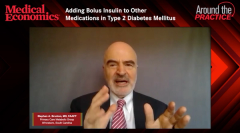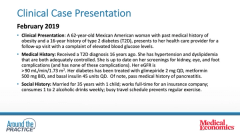
Considering an insulin pump for Type 2 Diabetes Mellitus
Episodes in this series

Dhiren Patel, PharmD, CDE, BC-ADM, BCACP: We were just talking about diabetes technology and how that can make some of the things our patients are doing a bit easier in that they shift the burden onto the device away from the patient.
Dr Busch, when we talk about diabetes technology, there are a few things that come to mind. We now have insulin pumps, so that’s what many have been thinking when we talk about diabetes technology. We now have CGM [continuous glucose monitoring]. We have connected insulin pens, smart pens. Let’s start with what’s really known regarding insulin pumps. When would you typically recommend an insulin pump for a patient with type 2 diabetes?
Robert Busch, MD: As we were talking about previously, they’re on 4 shots of insulin a day, and they’re forgetting their lunchtime dose. With the burden of remembering to take the 4 shots a day, that’s when I would automatically bring up the possibility of a pump for the patient with 1 type of insulin rather than 2 types of insulin for the convenience that they have the insulin with them at all times. Certainly, if the patient has had hypoglycemia, then pairing the continuous monitoring with the pump and the automatic shutoff feature would be a big improvement to the patients and for safety reasons as well.
Dhiren Patel, PharmD, CDE, BC-ADM, BCACP: This question is for everyone. What are some expectations that you have as a provider? What are some of the expectations that your patients have? If it’s anything like some of the consultations I get, it’s “please evaluate” or “patient wants an insulin pump.” Not everyone is going to be a candidate. We talked bit about how patients who are on multiple daily injections tend to be good candidates if you want to look or screen for those patients. What about some of the other characteristics and expectations that you have as a provider as well as those your patients have?
Diana Issacs, PharmD, BCPS, BCACP, BC-ADM, CDCES: First, I want to add that people sometimes have this false idea that being on an insulin pump somehow means that you have really bad diabetes or that you’ve failed. I try to break that misconception because insulin pumps are just another way of insulin delivery. I agree: For anyone who’s on multiple daily injections, an insulin pump is another way to be able to deliver that insulin. I try to introduce that idea early on to make sure people understand that it can be an option and to learn more about that because I’m a big fan of people knowing about the different options that are out there.
In terms of some other things to think about, 1 is that there is some dexterity required or at least help. With the insulin pumps, there is a process of drawing insulin out of the vial and being able to fill it up, so either the patient needs to be able to do that or at least have someone who can help the person be able to do it. There are some key education points too about understanding how insulin delivers in a pump. I get people with whom I’ve had insulin pump starts, and people come to me and don’t even realize it’s just 1 insulin going in there. They think that they’re supposed to put their long-acting and their rapid-acting insulin in there. The education about how a pump delivers insulin is important as well as understanding that the pump is the source of insulin delivery, so that means if you take your pump off, you don’t have any background insulin going on. That is an important education point, and I want to make sure people are aware of these things, so they don’t have severe hypoglycemia and hyperglycemia.
Stephen A. Brunton, MD, FAAFP: An important point Diana makes is also recognizing that this gives a sense of freedom to the patients. They don’t have to keep worrying all the time if they have their insulin with them. They can adjust easily and discreetly when they need to give themselves insulin. It’s an educational process. We have folks who can help do that, but once a patient gets used to the pump, they’re wondering why they went so long without it.
Dhiren Patel, PharmD, CDE, BC-ADM, BCACP: The other thing that I sometimes see is something I’m hoping to see less of: clinician bias when we think about diabetes technology, specifically when we think about an insulin pump. I’ll hear comments, “The patient can barely check their blood sugars, so I don’t think they’re a candidate.” You’ve seen different versions of patients who you didn’t think were going to do great, but they do great on it. When you think about which patients of yours are going to be candidates, beyond those with multiple daily injections, what are some things you could talk about in terms of the wide usage? Who are the potential candidate patients who could potentially benefit from this technology? Diana, do you want to start?
Diana Isaacs, PharmD, BCPS, BCACP, BC-ADM, CDCES: Sure. You bring up a good point because I unfortunately have seen too many providers say, “This patient’s A1C [glycated hemoglobin] is over 9% or over 10%, so they can’t do it. They have to get their A1C down first before they can go on a pump.” I don’t think we should ask people or make them earn their right to using a pump. That being said, there are certain things that will set up a person up for success over others. One is being willing to come in for that education before starting the pump and basic things like understanding how to treat hypoglycemia and doing that appropriately. Those are baseline things I want to make sure a person understands before they start a pump.
I also want to make sure that they can be committed to some form of monitoring because when we go from injections to a pump, we usually start a bit more conservatively because we don’t want to cause hypoglycemia. We need to monitor that to be able to fine-tune their doses, so we need some level of monitoring, whether that’s wearing a CGM or agreeing to do a certain number of finger sticks, as well as making sure that they come in for a follow-up. I’ve experienced it all. I’ve had someone come in for that initial training and never come back, and that was usually not successful. It’s not that there’s so much that’s needed; it’s about having that follow-up to fine-tune the settings and troubleshoot. We’ll usually do the training in 2 hours, but we know that with adult learning or pediatric learning principles, whatever they are, you don’t retain everything you’ve learned in those 2 hours. Having some follow-up for reinforcement is important.
Dhiren Patel, PharmD, CDE, BC-ADM, BCACP: Bob, what are your comments here?
Robert Busch, MD: Patients should understand that, after the education process, we’re still doing some adjustments based on carbohydrate counts with ratios and a correction factor in modifying those things with whoever is educating them regarding that. It’s not just 1 size fits all; where we say, “You’re on 1:10 and a 1:50 correction. Here’s your basal insulin, goodbye, go home, see you in 3 months.” There has to be a lot of communication back and forth until they get into the process of things and what that means for the patient.
Newsletter
Stay informed and empowered with Medical Economics enewsletter, delivering expert insights, financial strategies, practice management tips and technology trends — tailored for today’s physicians.


















